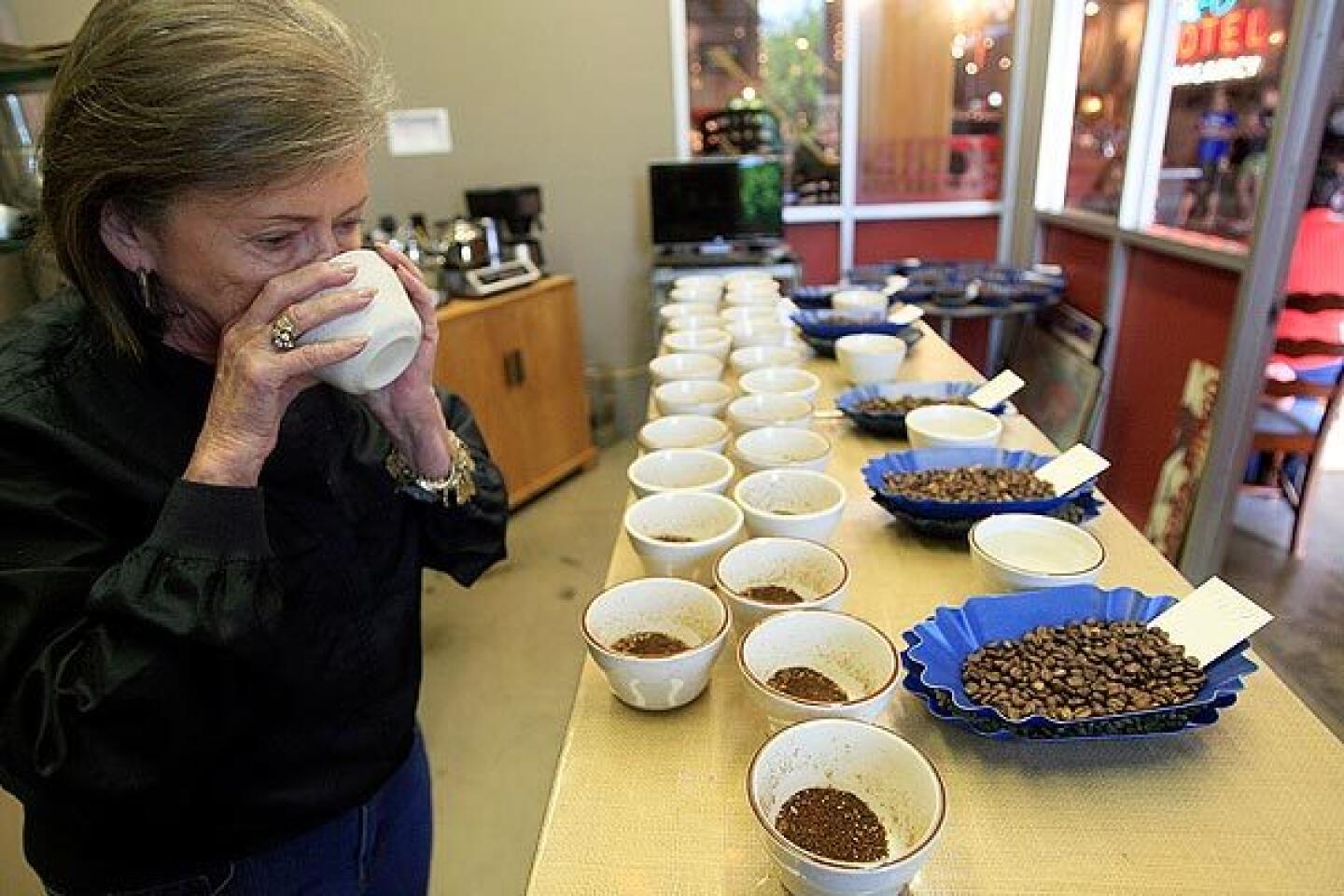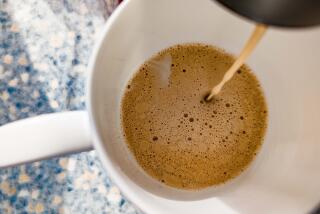The next DIY frontier: roasting coffee beans at home
Four students are standing over a hot stove in the creamery of the Institute of Domestic Technology on a late-October Sunday at the Zane Grey Estate in Altadena. Each one is manning a hand-cranked Whirley-Pop popcorn popper filled not with popcorn but green coffee beans from Costa Rica. The raw coffee beans turn golden, then brown, then start to expand and crackle.
A moment or two later, as the beans sizzle: “You hear that? That’s second crack!” says instructor Ian Riley, explaining the point at which the coffee’s woody cell walls fracture and its sugars continue to caramelize. “The smoke is fine,” he adds, as a fan next to a window over the stove pulls toasty exhaust into the yard where several Nubian goats are roaming. “Second crack sounds more like Rice Krispies.”
Riley’s a professional roaster at coffee company LA Mill in Alhambra but is enthusiastic about home roasting. “I hope you all go home and become amateur roasters and then professional roasters.”
A new generation of home coffee roasters already is energized by taking raw beans and transforming them into fodder for their Mazzer grinders and Clever drippers. As the DIY movement that has propelled kitchen crafts such as pickling meets “third wave” coffee (or the vanguard of the specialty coffee industry), roasting beans at home is the next frontier.
“This is one more step in my do-it-yourself quest,” says Ryan Gillespie, a 35-year-old production planner for Herbalife who signed up for the two-hour class. He’s wearing a T-shirt that reads “Haikus are easy/But sometimes they don’t make sense/Refrigerator” and has a manual coffee grinder tucked in his tote bag. The Koreatown resident also brews beer, bakes bread and lately has been canning dilled carrots and sweet pumpkin pickles.
Gillespie bought a Whirley-Pop and a sampler of green coffee beans from a website four months ago and now roasts coffee every few weeks. “When I started, I read a book and followed the instructions and came out with coffee that was pretty good, but I want to keep improving.”
The class, says Joseph Shuldiner, founder of the new Institute of Domestic Technology, was inspired by a roaster at the erstwhile Altadena Urban Farmers Market, who was making small batches in a popcorn popper. “I’m a coffee snob, and it was really good. I was excited by the craft of it,” Shuldiner says, “and blown away by how simple it is and how much control you could get from it.”
The institute “is about food crafting, about making your own food, making your own ingredients and learning how ingredients are made. We’re so used to buying coffee beans, one rarely thinks about where they come from and how are they roasted,” Shuldiner says.
You can roast coffee in a pot or pan, certain hot-air popcorn poppers or a dedicated machine. Green beans are heated to draw out moisture, caramelize sugars and bring out aromatics. (You can’t grind green coffee beans and make coffee as we know it.)
Basically, roasting occurs between the time the beans start to color and two significant stages: First crack (a cracking sound), which indicates the bean structure is breaking down as water escapes, sugars caramelize and oils are released, and second crack, when it’s said the roasted character starts to eclipse the beans’ original character. The “sweet spot” depends on your technique and taste, whether you prefer a light or dark roast.
Bad coffee or limited access to great beans might have compelled previous home roasters to take matters into their own hands. But the latest wave comes at a time when consumers have access to better-than-ever commercial coffee. Indeed, here in Southern California there’s a local roaster boom, with the coming of Handsome Coffee downtown and True Beans in Long Beach, for example.
Yet DIYers, who know their Finca La Fany coffee from Finca La Maravilla and the nuances of “city roast” from “full city-plus roast,” have embraced the thrill of cooking their own beans, whether with an electric hot-air popcorn popper or even small commercial machines that turn out pounds at a time. Green coffee beans generally cost about half the price of roasted beans.
Sweet Maria’s, the Oakland company that sells green beans and roasting equipment online, started in 1997 as a source for those who “we thought would be in tiny towns and didn’t have access to local roasters,” says co-owner Maria Troy. “I guess it’s funny — but a lot of our customers are in the Bay Area and other urban areas. They just like it, being involved in the roast and determining the process.”
She estimates that the company, which includes a wholesale business, sold 850,000 pounds of beans (most of them green) last year, up 10% from the year before. “It’s steadily grown despite the fact that we don’t advertise.”
Christopher Schooley, chairman of the Roasters Guild (a trade guild of the Specialty Coffee Assn. of America), says roasting has become much more accessible “because there’s a lot more information about coffee in general out there.” He also says that home roasters can get the same quality of beans as professional roasters and admits that you can get good coffee out of an air popper sold for popcorn.
But he doesn’t downplay the experience it requires. “It takes skill. Knowing what to draw out of that coffee is important. You can’t just walk up to a machine and do it.”
He also notes that more professionals are coming from a home roasting background.
“I started with a cast iron pot and a wooden spoon” two years ago, says Greg Thomas, who works in information technology at KNBC and KVEA and now roasts coffee out of his home in Atwater Village on a Diedrich IR-1 commercial roaster, making enough to sell a small amount to anyone interested in bags he labels Trystero (it’s a Thomas Pynchon reference).
“My personal grail is to have my own cafe,” Thomas says. “I’m as serious [about coffee] as the big names but want something just old-school and funky.”
He’s been roasting a caramel-y Rwandan (a few bags recently were sold at Demitasse cafe downtown), which is also part of his Lot 49 blend and “a Guatemalan bean that’s actually on the brighter side for pour-overs and French press,” he says. “We’ve got an Ethiopian bean on the way, and we have our Sumatran. I don’t push the Sumatran on people a lot — it’s got some forest-y flavors that a lot of people don’t get.”
One day Thomas’ friend Nicholas Rucka, a 36-year-old commercial editor, stops by to show off his Behmor, a home drum roaster he bought in March that looks a lot like a toaster oven. He’s got it plugged in outside in the frontyard as Hüsker Dü and the Fall play over the speakers. A couple of hangers-on joke about his setup: “You guys could have a roast-off. You know, like a latte throwdown or a chili cook-off.”
Rucka checks the timer on his Behmor while listening for first crack. “You really can just get a roaster, have half a clue and be interested, and get a good cup of coffee,” he says. “I roast 1 pound once a week. It’s an hour of my time, and I have a really fantastic cup of coffee all week. It’s really fun….
“This solves what I’m going to give for holiday gifts. I’ll just roast a … load of coffee. Everybody loves a good cup of coffee.”
More to Read
Eat your way across L.A.
Get our weekly Tasting Notes newsletter for reviews, news and more.
You may occasionally receive promotional content from the Los Angeles Times.














